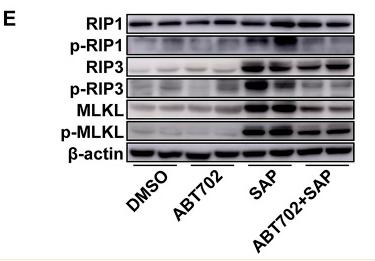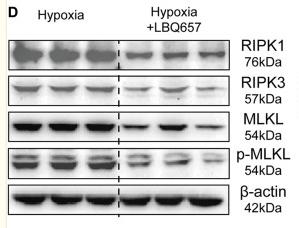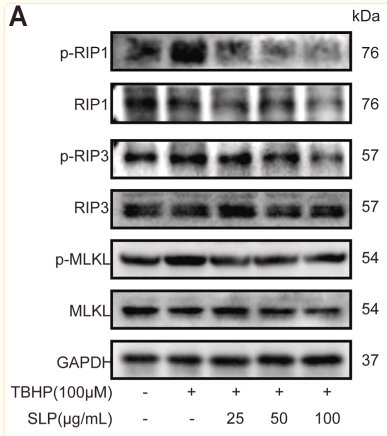Phospho-MLKL (Ser358) Antibody - #AF7420
| 製品: | Phospho-MLKL (Ser358) Antibody |
| カタログ: | AF7420 |
| タンパク質の説明: | Rabbit polyclonal antibody to Phospho-MLKL (Ser358) |
| アプリケーション: | WB IHC |
| Cited expt.: | WB, IHC |
| 反応性: | Human, Mouse, Rat |
| 分子量: | 54kDa; 54kD(Calculated). |
| ユニプロット: | Q8NB16 |
| RRID: | AB_2843860 |
製品説明
*The optimal dilutions should be determined by the end user. For optimal experimental results, antibody reuse is not recommended.
*Tips:
WB: For western blot detection of denatured protein samples. IHC: For immunohistochemical detection of paraffin sections (IHC-p) or frozen sections (IHC-f) of tissue samples. IF/ICC: For immunofluorescence detection of cell samples. ELISA(peptide): For ELISA detection of antigenic peptide.
引用形式: Affinity Biosciences Cat# AF7420, RRID:AB_2843860.
折りたたみ/展開
9130019I15Rik; FLJ34389; hMLKL; Mixed lineage kinase domain like; Mixed lineage kinase domain like protein; Mixed lineage kinase domain like pseudokinase; Mixed lineage kinase domain-like protein; Mlkl; MLKL_HUMAN;
免疫原
A synthesized peptide derived from human MLKL around the phosphorylation site of Ser358.
- Q8NB16 MLKL_HUMAN:
- Protein BLAST With
- NCBI/
- ExPASy/
- Uniprot
MENLKHIITLGQVIHKRCEEMKYCKKQCRRLGHRVLGLIKPLEMLQDQGKRSVPSEKLTTAMNRFKAALEEANGEIEKFSNRSNICRFLTASQDKILFKDVNRKLSDVWKELSLLLQVEQRMPVSPISQGASWAQEDQQDADEDRRAFQMLRRDNEKIEASLRRLEINMKEIKETLRQYLPPKCMQEIPQEQIKEIKKEQLSGSPWILLRENEVSTLYKGEYHRAPVAIKVFKKLQAGSIAIVRQTFNKEIKTMKKFESPNILRIFGICIDETVTPPQFSIVMEYCELGTLRELLDREKDLTLGKRMVLVLGAARGLYRLHHSEAPELHGKIRSSNFLVTQGYQVKLAGFELRKTQTSMSLGTTREKTDRVKSTAYLSPQELEDVFYQYDVKSEIYSFGIVLWEIATGDIPFQGCNSEKIRKLVAVKRQQEPLGEDCPSELREIIDECRAHDPSVRPSVDEILKKLSTFSK
研究背景
Pseudokinase that plays a key role in TNF-induced necroptosis, a programmed cell death process. Activated following phosphorylation by RIPK3, leading to homotrimerization, localization to the plasma membrane and execution of programmed necrosis characterized by calcium influx and plasma membrane damage. Does not have protein kinase activity. Binds to highly phosphorylated inositol phosphates such as inositolhexakisphosphate (InsP6) which is essential for its necroptotic function.
Phosphorylation by RIPK3 induces a conformational switch that is required for necroptosis. It also induces homotrimerization and localization to the plasma membrane.
Cytoplasm. Cell membrane.
Note: Localizes to the cytoplasm and translocates to the plasma membrane on necroptosis induction.
The protein kinase domain is catalytically inactive but contains an unusual pseudoactive site with an interaction between Lys-230 and Gln-356 residues. Upon phosphorylation by RIPK3, undergoes an active conformation (By similarity).
The coiled coil region 2 is responsible for homotrimerization.
Belongs to the protein kinase superfamily.
研究領域
· Cellular Processes > Cell growth and death > Necroptosis. (View pathway)
· Environmental Information Processing > Signal transduction > TNF signaling pathway. (View pathway)
参考文献
Application: IHC Species: Mouse Sample: liver
Restrictive clause
Affinity Biosciences tests all products strictly. Citations are provided as a resource for additional applications that have not been validated by Affinity Biosciences. Please choose the appropriate format for each application and consult Materials and Methods sections for additional details about the use of any product in these publications.
For Research Use Only.
Not for use in diagnostic or therapeutic procedures. Not for resale. Not for distribution without written consent. Affinity Biosciences will not be held responsible for patent infringement or other violations that may occur with the use of our products. Affinity Biosciences, Affinity Biosciences Logo and all other trademarks are the property of Affinity Biosciences LTD.








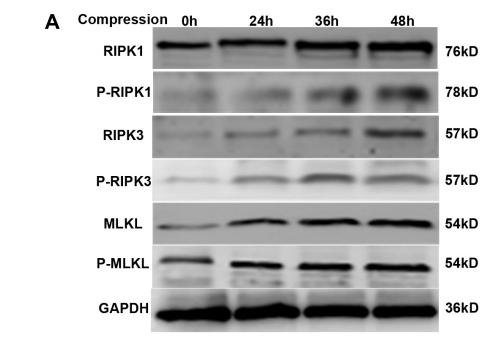
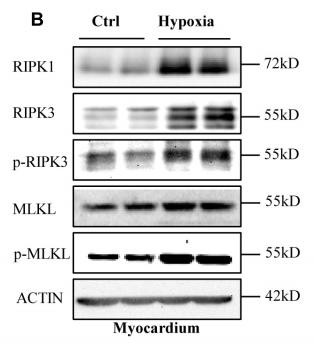
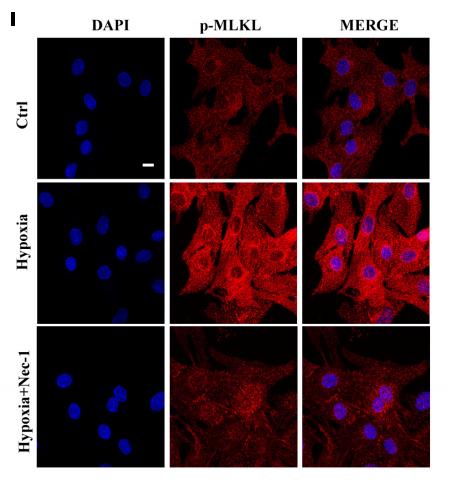



![Figure 6.
Effect of PPO on the necroptosis signalling pathway. (A) Western blot for necroptosis proteins, including TNF-α, TNFR1, RIPK1/3 and p-MLKL/MLKL. (B–F) Quantification of the western blot protein bands. All data are presented as the mean ± SEM. *p < 0.05, **p < 0.01, and ***p < 0.001 vs. sham; #p < 0.05 and ##p < 0.01 vs. CA; &p < 0.05 and &&p < 0.01 vs. Gly. PPO: pomelo [Citrus maxima (Burm.) Merr. cv. Shatian Yu] peel oil; TNF-α: tumour necrosis factor-α; TNFR1: tumour necrosis factor receptor 1; RIPK1/3: receptor-interacting serine/threonine kinase 1/3; MLKL: mixed lineage kinase domain-like protein; p-MLKL: phosphorylated mixed lineage kinase domain-like protein; SEM: standard error of the mean; sham: sham-operated group; CA: cardiac arrest/0.9% saline group; Gly: 10% glycerol group. Phospho-MLKL (Ser358) Antibody - Figure 6.](http://img.affbiotech.cn/images/cited_image/202209/cite-wx-1050-1662714320.jpg)

